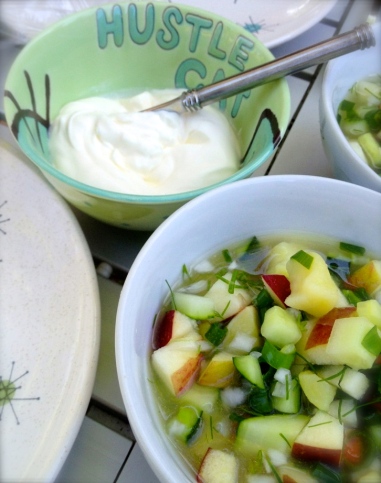
 This is the book of the generations of sourdough starter. Well, blog post, anyway.
This is the book of the generations of sourdough starter. Well, blog post, anyway.
As described earlier, our Bread 101 class is making sourdough as a lab project. If you’re interested in participating or following along, we are making baker Chad Robertson’s rather complex and detailed starter recipe from his book Tartine Book No. 3. My fellow instructors Elly and Karen are blogging their experiences, too, so check out Elly’s detailed daily blog entries and recipes at We’re Out of Eggs, I’ll Use Asparagus and Karen’s blog musings on fermentation and local cooking at Fairmount Neighborhood Farmers Market.
The upper right image is my initial starter made with 50/50 Open Oak Farm ‘Maris Widgeon’ wheat and King Arthur unbleached white flour. Maris Widgeon is a bread flour that is grown in the Willamette Valley by the Open Oak/Adaptive Seeds family, but was developed 50 years ago for roof thatching in Europe.
The starter is almost unhappily tart with lactobacilli, the same beasties that create the sour in sauerkraut and yogurt. With the almost constant fermentation I do, my kitchen is full of them. The image on the upper left is the result of feeding a piece of the initial starter with more flour and water and letting it sit for another day to beget starter 2.0. 24 hours later, nearly godlike, I took a piece of starter 2.0 and fed it with more flour and water to beget starter 3.0. The bottom image is starter 3.0, forming nice bubbles and smelling much more yeasty and pleasant rather than lactic.
All of us on the teaching team had the same reticence about the waste that goes into creating this sourdough starter. The general idea is to ferment a couple cups of a flour-water paste, then pour off a small amount (75 grams, if you must know) then feed that little piece (250 grams of water and flour, if you must know) for 24 hours, then start again, repeating for several days. Some of us reduced the initial inputs. Others (like me!) made sourdough pancakes with the leftover fermented batter. And they weren’t bad!
Be sure to check out Elly’s recipe and process for sourdough pancakes, which differs from mine. For more on the fermentation process, see Karen’s entry on her starter.
EDITED TO ADD: After a week or so of feeding, the starter has calmed down and is smelling more yeasty now, nice and gently sour, more bready than sauerkrauty. Collateral damage, though, perhaps: did the yeasts affect my latest batch of crème fraîche, souring next to the sourdough? It failed to set up and grew mold on top almost immediately. It’s always a wild ride with fermentation!
Sourdough Pancakes
Serves 4 with bacon.
- 2 cups fresh sourdough starter
- 1 egg
- 3 tablespoons maple syrup
- 2 tablespoons vegetable oil
- 1 teaspoon baking soda
- 3 tablespoons milk AND/OR 3 tablespoons cornmeal or flour
- 1 tablespoon butter or coconut oil
Combine starter, egg, syrup, oil, and baking soda. Use some milk to thin the batter to a pancake batter consistency OR add some cornmeal or flour if the batter seems too thin. You will need to use your judgment and your own pancake tastes – some like them thicker and fluffier than others. I ended up using both milk and cornmeal to find a perfect balance between batches.
Let the batter sit on the counter for 10-15 minutes to allow baking soda to do its magic. Heat nonstick skillet or griddle to medium heat. Add butter or coconut oil, coating pan as it melts, then pour 3-4-inch diameter rounds of batter for each pancake.
Prepare in batches, cooking pancakes until the surface is well bubbled and mostly dry on top, then flip over and cook for a few minutes more. You are looking for golden brown surfaces on both sides. The pan is too hot if it burns unevenly, and too cool if the pancake just soaks up the butter and doesn’t brown.
Serve with maple syrup. You may freeze leftover cooked pancakes on a cookie sheet, IQF (individually-quick-frozen) style, then pop them off the sheet and store in freezer bags for a quick breakfast.


























You must be logged in to post a comment.